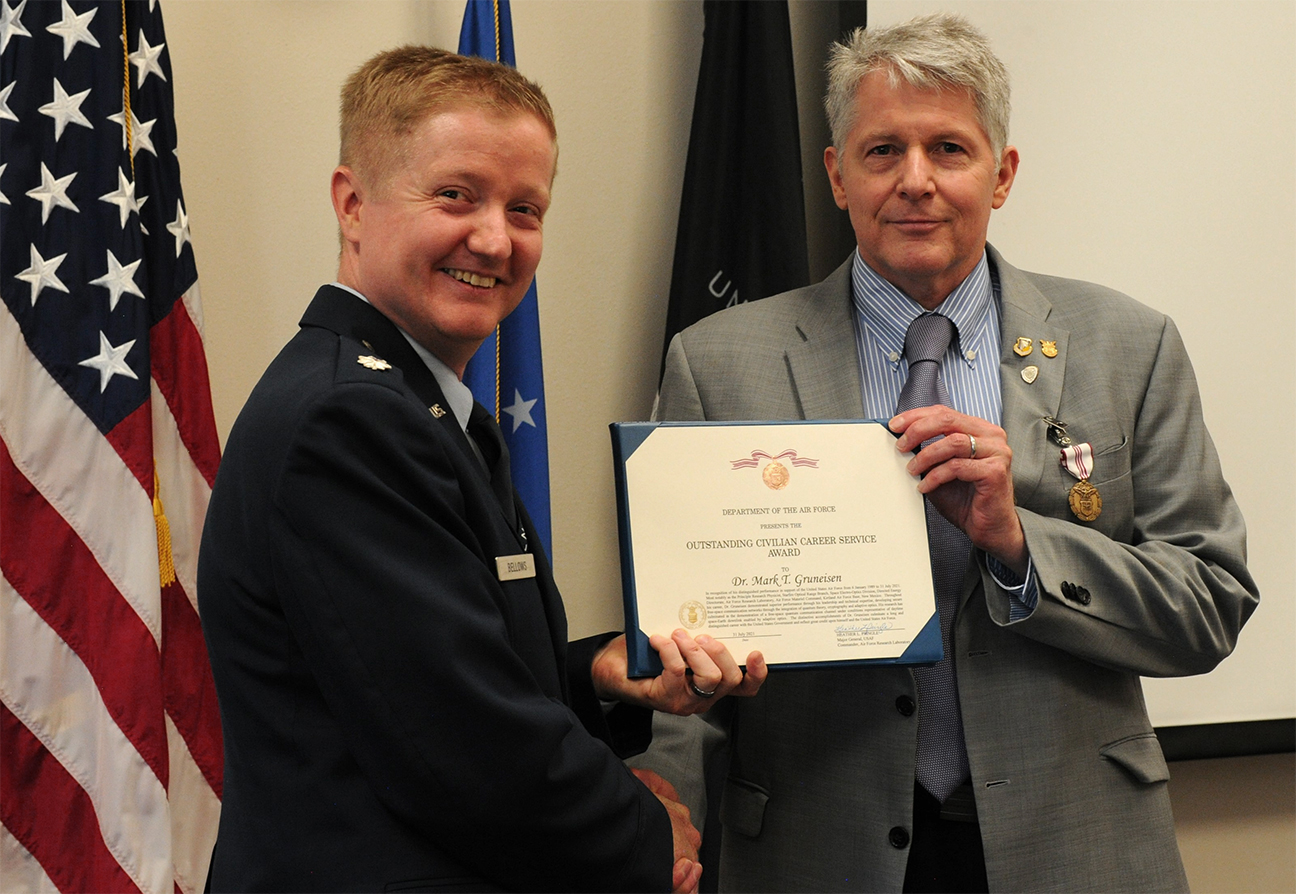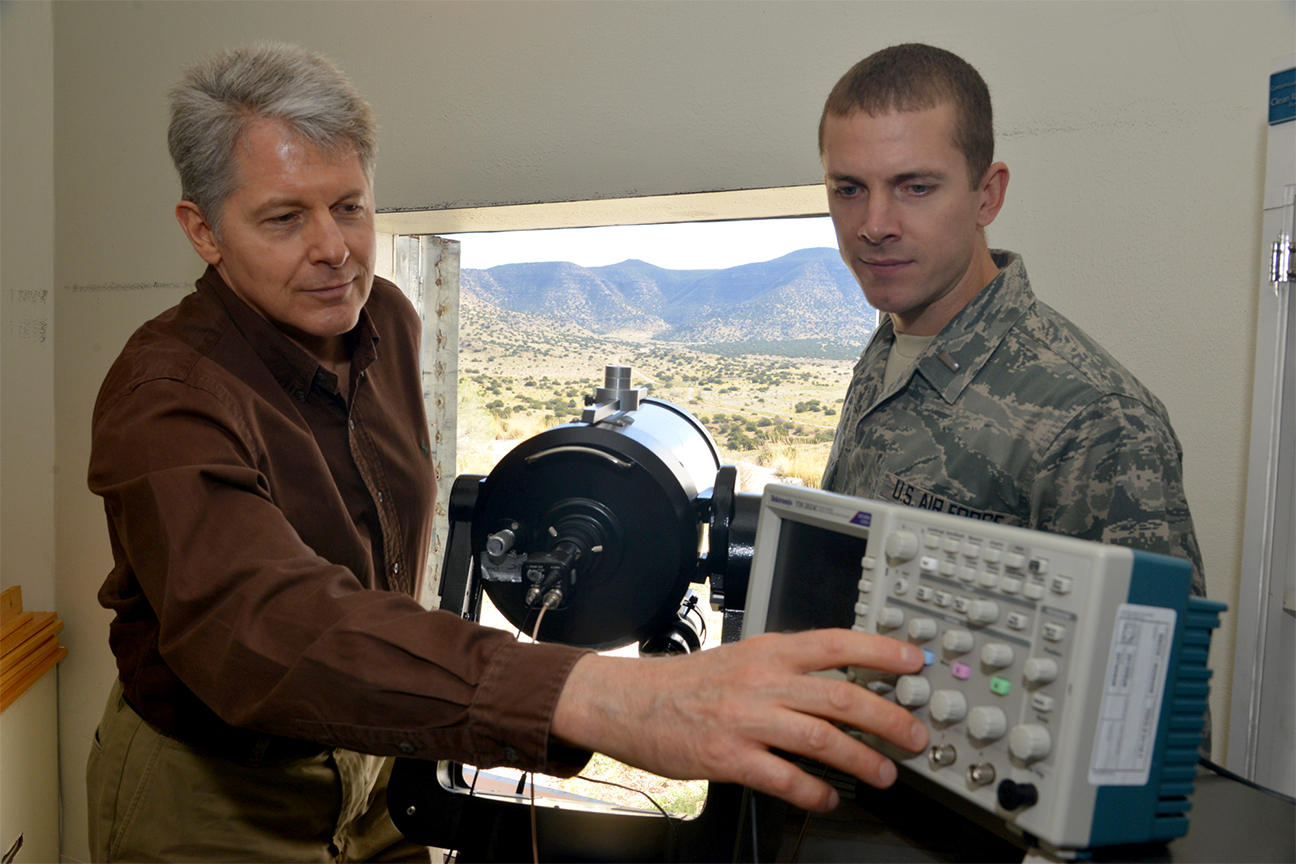AFRL quantum expert makes groundbreaking advances coinciding with his retirement
KIRTLAND AIR FORCE BASE, N.M. (AFRL) – “The first country to harness the power of quantum networking will achieve technological supremacy,” said Dr. Mark Gruneisen, Air Force Research Laboratory senior research physicist and quantum expert.
Gruneisen is the Principle Investigator for Quantum Communications at the AFRL Directed Energy Directorate’s Starfire Optical Range located here.
After 32 years of pioneering and groundbreaking research in optical wavefront control and quantum communications, Gruneisen retired from federal service at the end of July, leaving a hard to fill gap. To put an exclamation point at the end of his career, he and his colleagues recently demonstrated a remarkable quantum experiment, that was years in the making.
“Mark has been the continuity and visionary for this program, and his recent successful test demonstrates this,” said Valerie Knight who leads SOR’s quantum research. “He is well known in the quantum optics community, and envisioned that we needed a quantum ground terminal many years ago, realizing that this would be the basis for all future work. We will miss Mark’s intelligence, foresight, and attentiveness to details.”
Gruneisen’s most recent success involved the completion of a field experiment demonstrating quantum communication under conditions representing a satellite communicating with a terrestrial ground terminal in daytime.
“Quantum communication is an essential element of the quantum internet which is anticipated to be a revolutionary leap in networking and computing,” Gruneisen said. “This is an ambitious concept for linking quantum computers around the globe with unprecedented security.”
Gruneisen explained that quantum communication is based on transmitting and receiving individual particles of light, and doing so against a bright sky background is extremely challenging.
“We all understand this intuitively as we cannot see even the brightest stars in daytime,” he said. “Daytime quantum communication with individual photons is fantastically more difficult. For over 20 years, there have been more than a dozen groups around the world working toward satellite-Earth quantum communication, but until now no one has demonstrated a solution to the daytime problem under realistic conditions.”
A primary application of the quantum internet is linking quantum computers in a way that is analogous to our modern digital internet, according to Gruneisen.
“Today’s computer technology is reaching its theoretical limit of performance,” he said. “Quantum computing is on the horizon and has the potential to be transformational and massively disruptive. Once a nation harnesses the power of quantum networking, it may be impossible for others to overcome such a technology gap. To make an analogy, imagine you have an abacus and you’re trying to achieve parity with a country that uses super computers to create new technologies and solve complex problems.”
In looking back at his career, Gruneisen has some observations about his time at AFRL.
“What I appreciate most about my career with AFRL is I’ve had numerous opportunities to work with outstanding scientists and engineers on exotic and novel technology concepts,” Gruneisen said. “I strongly believe this kind of high-risk high-payoff research is crucial for defense in the modern era. We do not want to be caught off guard with an unexpected breakthrough by others.”
Gruneisen is proud of his work at AFRL’s Starfire Optical Range, which the Department of the Air Force has identified to transfer to the U.S. Space Force.
“With the quantum communication topic in the Directed Energy Directorate, I’ve had the opportunity to define and lead a modeling and simulation effort, and grow that into a significant experimental program and demonstration at the SOR,” he said. “I’m extremely proud of the SOR team and our results which are now being published.”*
Interesting youth in STEM studies, as a way to grow the science and technology workforce, is important to AFRL. Gruneisen said he would encourage any young person considering quantum as a career to do so.
“The underlying physics concepts, such as quantum entanglement, are truly fascinating,” he said. “Beyond being interesting, this rapidly growing area has the potential to become the economy of the future much as the internet fuels today’s economy. There will be plenty of opportunities for careers as experimentalists, theoreticians, engineers, technicians, and business leaders. Get the best education you can in science, technology, engineering, and math.”
The SOR held a farewell retirement event in Gruneisen’s honor July 28, attended by many colleagues, family and friends.
“One of the highlights of my career has been the opportunity to work with Mark,” said Air Force Lt. Col. Charlie Bellows, who officiated the ceremony, and is the SOR’s chief engineer. “Mark has provided visionary leadership for the nation and the world in the field of quantum physics. His work has helped lay the foundation that will propel the DOD quantum advances into 2030 and beyond.”
“Dr. Gruneisen’s legacy will continue for decades to come,” Bellows emphasized. “He has been an incredible quantum leader and mentor throughout his career.”
Note: As an added bonus to his retirement, Gruneisen received notice from the American Physical Society that the organization published his paper on “adaptive optics enabled quantum communications” July 29, his final day in the office.**
**URL: https://link.aps.org/doi/10.1103/PhysRevApplied.16.014067
*M. T. Gruneisen, M. L. Eickhoff, S. C. Newey, K. E. Stoltenberg, J. F. Morris, M. Bareian, M. A. Harris, D. W. Oesch, M. D. Oliker, M. B. Flanagan, B. T. Kay, J. D. Schiller, and R. N. Lanning, “Adaptive-Optics- Enabled Quantum Communication: A Technique for Daytime Space-To-Earth Links,” Phys. Rev. Applied 16, 014067 (2021).

Dr. Mark Gruneisen, AFRL Starfire Optical Range senior physicist and quantum communications expert, completed groundbreaking research that coincides with his retirement after 32 years of federal service. (U.S. Air Force photo/2nd Lt. Benjamin Glenn)

Dr. Mark Gruneisen, AFRL Starfire Optical Range senior physicist and quantum communications expert, retired after 32 years of federal service and groundbreaking research in optical wavefront control and quantum communications. (U.S. Air Force photo/Todd Berenger)
